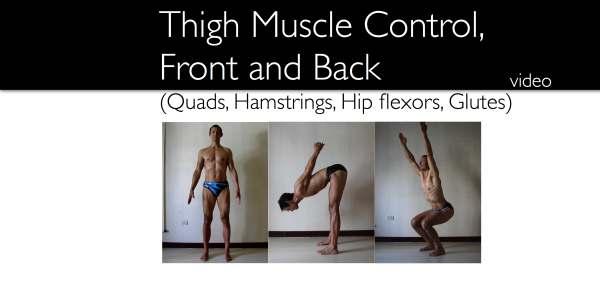Thigh Muscle Control, Front and Back
On page cat links
This is a video workshop.
Thigh control is one of the first "conscious muscle control" techniques that I began to teach.
It originated as a tool for active stretching. The particular technique that I initially used was also helpful when I had an injured knee. Activating my thighs using one of the techniques in this video allowed me to continue to teach yoga while still demonstrating the poses without exasperating my knee pain.
I'd twisted my knee. I never did find out what was damaged. Deliberately activating leg and hip muscles in different ways seemed to help me get over that problem and others that I've had.
For some people using different thigh activations (along with different "intents") while stretching helped them to increase their flexibility.
It helped me get past a sticking point in hamstring flexibility. The thing is, this technique doesn't work for everybody to improve flexibility.
However, it is a part of improving body awareness.
Muscles don't just create movement, they create sensation. They also help to keep our joints lubricated.
With muscle control you not only improve control of your body, you improve your ability to feel your body, and you have a better chance of keeping your joints lubricated in various activities.
Thigh Muscle Control (front and back) is a starting point for learning to feel and control your muscles and for getting more awareness of your body.
Because I encountered some students who had difficulty feeling their thighs with my initial teaching technique, I had to develop other ways of helping them to activate and feel their thighs. These where generally very flexible or very light students.
Even if you can feel your muscles using the first technique, trying the second technique will give you a better understanding of how your body works as well as an optional technique for activating your muscles.
If you are a teacher it gives you two tools for helping your students learn to feel and control their body.
The muscles you learn to feel and control are the quadriceps and hip flexors (the front of the thigh and front of the hip) and hamstrings and gluteus maximus (the back of the thighs and back of the hip.
Knee activation is touched on briefly (since both the hamstrings and quadriceps both act on the knee) however the main focus is on learning to activate and feel the activation of the muscles at the front and back of your thigh and hip.
Videos can be streamed or downloaded (the downloads are MP4 format).
Video Layout
The first set of videos focuses on the front of the thigh. The first videos teach you to activate your quadriceps and hip flexors in relative isolation. Alternate exercises are in a separate video (which is also included).
The final video takes you through a short set of poses during which you practice quadriceps and hip flexor activation. This gives you the chance to improve your muscle control so that you can then use it in other poses at will (even ones not included in this video).
In addition, it gives you a chance to notice how muscle control can make a difference to the feeling of a pose. You may find that your poses in some cases feel more stable. You may find that muscle control doesn't help in all poses and that's important too. With muscle control you develop the ability to experiment and see what activations help in particular poses and what activations dont.
The second set of videos follows the same pattern as the first but focuses on the hamstrings and gluteus maximus muscles.
Muscle control is first taught in isolation, and includes alternate exercises for muscle activation if you can't feel your muscles using the first technique.
As with the first set of videos, the second set finishes with a set series of poses in which you practice hamstring and glute activation.
30 Day Guarantee
I've used these exercises in my classes to teach students of a wide range of abilities and body awareness to feel and control their quads/hamstrings/hip flexors and glutes. If you aren't satisfied, if these exercises don't help, use the contact form and let me know within thirty days of purchase and I'll refund the cost of your purchase.
Click below to Purchase
Buy: Thigh Muscle Control (Quads and Hams) video ($24.00)Or order directly on the gumroad page.
Once you've ordered, you'll be able to download this video or stream it
If you have any problems use the contact form to get in touch with me.



